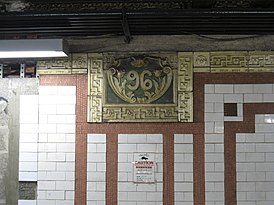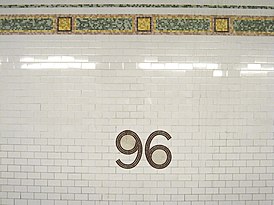96th Street station (IRT Broadway–Seventh Avenue Line)
96 Street Intercampus Shuttles | |||||||||||||||||||||||||||||||||||||||||||||||||||||||||||||||||||||||||||||||||||||||||||||||||||||||||||||||||||||||||||||||||||||||||||||||||||||||||||||||
|---|---|---|---|---|---|---|---|---|---|---|---|---|---|---|---|---|---|---|---|---|---|---|---|---|---|---|---|---|---|---|---|---|---|---|---|---|---|---|---|---|---|---|---|---|---|---|---|---|---|---|---|---|---|---|---|---|---|---|---|---|---|---|---|---|---|---|---|---|---|---|---|---|---|---|---|---|---|---|---|---|---|---|---|---|---|---|---|---|---|---|---|---|---|---|---|---|---|---|---|---|---|---|---|---|---|---|---|---|---|---|---|---|---|---|---|---|---|---|---|---|---|---|---|---|---|---|---|---|---|---|---|---|---|---|---|---|---|---|---|---|---|---|---|---|---|---|---|---|---|---|---|---|---|---|---|---|---|---|---|
| Structure | Underground | ||||||||||||||||||||||||||||||||||||||||||||||||||||||||||||||||||||||||||||||||||||||||||||||||||||||||||||||||||||||||||||||||||||||||||||||||||||||||||||||
| Platforms | 2 island platforms (in service) cross-platform interchange 2 side platforms (abandoned) | ||||||||||||||||||||||||||||||||||||||||||||||||||||||||||||||||||||||||||||||||||||||||||||||||||||||||||||||||||||||||||||||||||||||||||||||||||||||||||||||
| Tracks | 4 | ||||||||||||||||||||||||||||||||||||||||||||||||||||||||||||||||||||||||||||||||||||||||||||||||||||||||||||||||||||||||||||||||||||||||||||||||||||||||||||||
| Other information | |||||||||||||||||||||||||||||||||||||||||||||||||||||||||||||||||||||||||||||||||||||||||||||||||||||||||||||||||||||||||||||||||||||||||||||||||||||||||||||||
| Opened | October 27, 1904[2] | ||||||||||||||||||||||||||||||||||||||||||||||||||||||||||||||||||||||||||||||||||||||||||||||||||||||||||||||||||||||||||||||||||||||||||||||||||||||||||||||
| Accessible | |||||||||||||||||||||||||||||||||||||||||||||||||||||||||||||||||||||||||||||||||||||||||||||||||||||||||||||||||||||||||||||||||||||||||||||||||||||||||||||||
| Opposite- direction transfer | Yes | ||||||||||||||||||||||||||||||||||||||||||||||||||||||||||||||||||||||||||||||||||||||||||||||||||||||||||||||||||||||||||||||||||||||||||||||||||||||||||||||
| Traffic | |||||||||||||||||||||||||||||||||||||||||||||||||||||||||||||||||||||||||||||||||||||||||||||||||||||||||||||||||||||||||||||||||||||||||||||||||||||||||||||||
| 2022 | 7,059,602[4] | ||||||||||||||||||||||||||||||||||||||||||||||||||||||||||||||||||||||||||||||||||||||||||||||||||||||||||||||||||||||||||||||||||||||||||||||||||||||||||||||
| Rank | 24 out of 423[4] | ||||||||||||||||||||||||||||||||||||||||||||||||||||||||||||||||||||||||||||||||||||||||||||||||||||||||||||||||||||||||||||||||||||||||||||||||||||||||||||||
| |||||||||||||||||||||||||||||||||||||||||||||||||||||||||||||||||||||||||||||||||||||||||||||||||||||||||||||||||||||||||||||||||||||||||||||||||||||||||||||||
| |||||||||||||||||||||||||||||||||||||||||||||||||||||||||||||||||||||||||||||||||||||||||||||||||||||||||||||||||||||||||||||||||||||||||||||||||||||||||||||||
| |||||||||||||||||||||||||||||||||||||||||||||||||||||||||||||||||||||||||||||||||||||||||||||||||||||||||||||||||||||||||||||||||||||||||||||||||||||||||||||||
| |||||||||||||||||||||||||||||||||||||||||||||||||||||||||||||||||||||||||||||||||||||||||||||||||||||||||||||||||||||||||||||||||||||||||||||||||||||||||||||||
| |||||||||||||||||||||||||||||||||||||||||||||||||||||||||||||||||||||||||||||||||||||||||||||||||||||||||||||||||||||||||||||||||||||||||||||||||||||||||||||||
| |||||||||||||||||||||||||||||||||||||||||||||||||||||||||||||||||||||||||||||||||||||||||||||||||||||||||||||||||||||||||||||||||||||||||||||||||||||||||||||||
The 96th Street station is an express station on the IRT Broadway–Seventh Avenue Line of the New York City Subway. Located at the intersection of 96th Street and Broadway on the Upper West Side of Manhattan, it is served by the 1, 2, and 3 trains at all times.
The 96th Street station was constructed for the Interborough Rapid Transit Company (IRT) as part of the city's first subway line, which was approved in 1900. Construction of the line segment that includes the 96th Street station began on August 22 of the same year. The station opened on October 27, 1904, as one of the original 28 stations of the New York City Subway. The 96th Street station's platforms were lengthened in 1960 as part of an improvement project along the Broadway–Seventh Avenue Line. A new head house and elevators were constructed between 2007 and 2010.
The 96th Street station contains two island platforms, two unused side platforms, and four tracks. The outer tracks are used by local trains while the inner two tracks are used by express trains. The station contains two sets of exits: a head house at the northern end, in the median of Broadway at 96th Street, as well as staircases at Broadway and 94th Street. The head house contains elevators, which make the station compliant with the Americans with Disabilities Act of 1990.
History
Construction and opening
Planning for a subway line in New York City dates to 1864.[5]: 21 However, development of what would become the city's first subway line did not start until 1894, when the New York State Legislature passed the Rapid Transit Act.[5]: 139–140 The subway plans were drawn up by a team of engineers led by William Barclay Parsons, the Rapid Transit Commission's chief engineer. It called for a subway line from New York City Hall in lower Manhattan to the Upper West Side, where two branches would lead north into the Bronx.[6]: 3 A plan was formally adopted in 1897,[5]: 148 and all legal conflicts concerning the route alignment were resolved near the end of 1899.[5]: 161
The Rapid Transit Construction Company, organized by John B. McDonald and funded by August Belmont Jr., signed the initial Contract 1 with the Rapid Transit Commission in February 1900,[7] under which it would construct the subway and maintain a 50-year operating lease from the opening of the line.[5]: 165 In 1901, the firm of Heins & LaFarge was hired to design the underground stations.[6]: 4 Belmont incorporated the Interborough Rapid Transit Company (IRT) in April 1902 to operate the subway.[5]: 182
The 96th Street station was constructed as part of the IRT's West Side Line (now the
Early 20th century
East Side local trains and West Side express trains crossed over at an at-grade junction north of 96th Street, creating heavy congestion during rush hours. In April 1907, the IRT submitted a report to the RTC, proposing to alleviate the congestion by building extra tracks.[9] On June 27, 1907, a modification called the 96th Street Improvement was made to Contract 1 to add additional tracks at 96th Street in order to remove the at-grade junction north of the 96th Street station.[10] Here, trains from Lenox Avenue and Broadway would switch to get to the express or local tracks and would delay service.[10][11] The new tracks would have been constructed with the necessary fly-under tracks and switches.[11][12]: 14 The estimated cost of the work was $850,000.[11][13] Neighboring property owners objected to the plan since the work required tearing up the street above the tunnel.[14] Accordingly, in December 1908, city officials announced they would introduce speed-control signals, making the 96th Street Improvement unnecessary.[13][14] Some ramps had already been completed, so provisions were left to allow the work to be completed later on. The signals were put into place at 96th Street on April 23, 1909. The new signals allowed trains approaching a station to run more closely to the stopped train, eliminating the need to be separated by hundreds of feet.[15]: 85–87, 191
When the station opened, the station served as the terminus of local trains; express trains would run as locals north to
The platforms were originally 350 feet (110 m) long, like at other express stations,[6]: 4 [20]: 8 [21] and 18 feet (5.5 m) wide.[21]: 106 To address overcrowding, in 1909, the New York Public Service Commission proposed lengthening the platforms at stations along the original IRT subway.[22]: 168 As part of a modification to the IRT's construction contracts made on January 18, 1910, the company was to lengthen station platforms to accommodate ten-car express and six-car local trains. In addition to $1.5 million (equivalent to $49.1 million in 2023) spent on platform lengthening, $500,000 (equivalent to $16.4 million in 2023) was spent on building additional entrances and exits. It was anticipated that these improvements would increase capacity by 25 percent.[23]: 15 At the 96th Street station, the northbound island platform was extended 100 feet (30 m) south, while the southbound island platform was extended 135 feet (41 m) south, necessitating the replacement of some structural steel girders.[23]: 111 Six-car local trains began operating in October 1910.[22]: 168 On January 23, 1911, ten-car express trains began running on the Lenox Avenue Line, and the following day, ten-car express trains were inaugurated on the West Side Line.[22]: 168 [24]
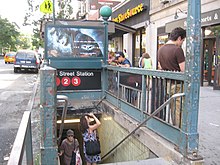
In 1915, the IRT considered constructing a new mezzanine and entrance at the southern end of the station leading to the central mall of Broadway at 94th Street, with an estimated cost of $60,000.
Mid- and late 20th century

The city government took over the IRT's operations on June 12, 1940.
On June 14, 1956, the New York City Transit Authority (NYCTA) announced a $100 million (equivalent to $1,120.7 million) project to modernize the IRT Broadway—Seventh Avenue Line and improve service. It was estimated that the project would be completed in 2.5 years.[34] In 1957, work began to lengthen station platforms between Times Square and 96th Street, with the exception of 91st Street, to 525 feet (160 m) to accommodate ten-car trains. Originally, stations north of Times Squares could barely fit local trains of five or six cars depending on the configuration of the trains. In 1960, work was completed on improvements at the 96th Street station, including the installation of fluorescent lighting, as well as platform extensions.[35][36][37] To make room for the platform extensions, the local tracks and the outside walls had to be moved. A new mezzanine with stairways to the street, and direct access to both express platforms, was built between 93rd and 94th Streets.[38][35]
Once most of the work on the project was completed on February 6, 1959, all 1 trains became local, running at an increased frequency, and all 2 and 3 trains became express, and eight-car local trains began operation.
On August 9, 1964, the NYCTA announced the letting of a $7.6 million (equivalent to $74.7 million) contract to lengthen platforms at stations from Rector Street to 34th Street–Penn Station on the line, and stations from Central Park North–110th Street to 145th Street on the Lenox Avenue Line. The completion of the project would allow express trains to be lengthened from nine-car trains to ten-car trains, and to lengthen locals from eight-car trains to ten-car trains.[42] In 1977, a special committee of the NYCTA Board issued a report advising the MTA to halt plans to reduce the hours of 21 token booths, including that at the 96th Street station. A member of the special committee said that the savings from reducing the hours at token booths often was not significant enough to outweigh inconveniences to riders.[43] By 1981, the Metropolitan Transportation Authority had listed the station among the 69 most deteriorated stations in the subway system.[44] In 1983, the MTA added funding for a renovation of the 96th Street station to its 1980–1984 capital plan.[45]
The 96th Street station was the location of a chase scene in the 1979
21st century
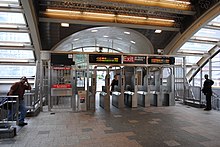
In July 2006, Manhattan Community Board 7 approved an $80 million renovation of the station. Construction started in 2007 on a new head house in the median of Broadway between 95th and 96th Streets, with elevators to the platforms to comply with the Americans with Disabilities Act of 1990 (ADA). Broadway was reconfigured for four blocks to accommodate this. By 2008, renovation of the 40,000 square feet (3,716 m2) station was nearly finished below budget (only $65 million was used to complete the renovation) and on schedule.[47] Urbahn Architects also restored the platform level to its original design.[48] By 2009, the opening of the new head house was set to be 20 months early and $26 million cheaper due to budget cuts.[49][50]
The new head house opened on April 5, 2010, and replaced the underpass and side platforms.[51][52][53] The side platforms became office and control space, and the entrances were removed to accommodate narrowed sidewalks to offset the new head house's protrusion into the roadway.[54] The elevators opened on November 9, 2010, making the station wheelchair-accessible.[55] Local residents voiced dissatisfaction with the significant loss of sidewalks adjacent to businesses.[56] The intersection of 96th Street and Broadway saw numerous pedestrian and vehicular crashes after its completion;[57] the New York Daily News described the crossing to the new station entrance as "treacherous" in 2014.[58]
An out-of-service 1 train collided with a revenue-service train near the station on January 4, 2024, injuring 26 on the latter train;[59] a subsequent investigation found that the crash might have been caused by human error.[60]
Station layout
| Ground | Street level | Fare control |
| Mezzanine | Crossover between platforms | |
| Platform level | Side platform, not in service | |
| Northbound local | ← (No regular service: 157th Street) ← | |
| Island platform | ||
| Northbound express | ← ← | |
| Southbound express | | |
| Island platform | ||
| Southbound local | (Closed: 91st Street) | |
| Side platform, not in service | ||
96th Street contains four tracks and two
The 96th Street station is fully wheelchair-accessible, with elevators connecting the street and platforms.[67] As a result of the 1958–1959 platform extension, the platforms are 520 feet (160 m) long.[38] During normal service, southbound local trains use track B1 and southbound express trains use track B2. Northbound express trains use track B3 and northbound local trains use track B4. These track designations are not posted in the station, but are used in the chaining of each individual track, used to measure distance by train crews on the subway.[68][61]
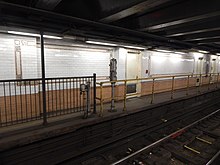
There are two unused
Before the completion of the main head house in 2010,[51] the station could be entered through stairways along the sidewalks of Broadway, to the extreme north end of the side platforms, then to the island platforms via an underpass. Engineers were unable to build a mezzanine level similar to other express stations for a few reasons. First, directly to the north of the station is an interlocking, and trains heading to the two branches are at the greatest gradients trains can operate on. Lowering the station to provide ample space for a mezzanine would have led to gradients that would have hindered efficient train operation. In addition, it was determined to be too costly to lower a large 6.5 feet (2.0 m)-wide trunk sewer in 96th Street, which was at the bottom of a drainage valley, enough to provide room for a mezzanine. The sewer was lowered 2.25 feet (0.69 m), when an additional 7 to 8 feet (2.1 to 2.4 m) of lowering would be needed to fit a mezzanine.[21]: 107
Design
As with other stations built as part of the original IRT, the station was constructed using a
The decorative scheme consists of red tile tablets, pink tile bands, a buff cornice, and buff plaques.[20]: 38 The mosaic tiles at all original IRT stations were manufactured by the American Encaustic Tile Company, which subcontracted the installations at each station.[20]: 31 The decorative work was performed by tile contractor Alfred Boote Company.[20]: 38
Track layout

North of 96th Street, there are crossovers between the uptown and downtown pairs of tracks, and between the express tracks. The express tracks then descend and turn east under West 104th Street and running northeast under Central Park on their way to the IRT Lenox Avenue Line at West 110th Street. The local tracks remain on the upper level to Riverdale, Bronx. After the express tracks diverge, a center track starts at approximately 100th Street; it is not in regular use.[61]
Some evidence remains of the 96th Street Improvement of 1907. As part of the project, one additional track would have run from 96th Street along the east side of Broadway, branching off the northbound local track and descending to the lower level, with a spur connecting to the Lenox tracks at 100th Street. The new northbound track would have then risen and merged with the northbound local track at 102nd Street. At 100th Street, a spur would connect to the other tracks. Two additional tracks would have been constructed, running along the west side of Broadway from 96th Street to 101st Street. The first of these two tracks would have branched off of the southbound local track and run parallel before merging back into that track at 101st Street. The second of these two tracks would have diverged from the first additional track on the west side of Broadway, and would run parallel and at the same grade until 98th Street. Here, the track would descend to the lower level. At 101st Street the track would curve and connect with the southbound track of the Lenox Avenue Line.[10][11] The completed parts of this project include the third northbound track, which was finished by February 1908.[11]
Entrances and exits
Current exits
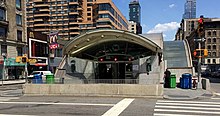
There are two sets of entrances and exits at the station.[70] The main, ADA-accessible entrance is through a domed, glass-clad head house on the Broadway median between 95th and 96th Streets.[53] According to the head house's designer Urbahn Architects, the structure "is a reinterpretation of the archetypal 19th Century train shed", with a vaulted roof made of titanium.[48] Entrances are on both the 95th and 96th Street sides of the head house. Above each of the head house's entrances, the entrance's name plaque reads simply "96" in white letters upon glass, and light-up red circles containing the numbers "1", "2", and "3", the services of the IRT Broadway–Seventh Avenue Line.[53][48] On the 96th Street side, there is a fare booth.
The head house contains an artwork by Sigi Moeslinger and Masamichi Udagawa, entitled Bloemendaal. The name recalls the historical name of the Bloomingdale neighborhood.[71][72] The work consists of 180 stainless-steel flowers,[71] each weighing 3 pounds (1.4 kg). The flowers are placed on seven ceiling beams 12 feet (3.7 m) high, and they can shake slightly to give the impression of a "shimmering garden".[72]
There are two staircases each at the southeastern and southwestern corners of 94th Street and Broadway. There is a crossover within fare control at this end of the station.[70]
Former exits
There were two staircases at the intersection of 96th Street and Broadway, one each at the southeastern and southwestern corners.
There was a control house in the median of Broadway (now removed), which dated to the station's opening in 1904. It was built as one of several station houses on the original IRT; similar station houses were built at Bowling Green and 72nd, 103rd, and 116th Streets.[74]: 46
References
Explanatory notes
- ^ a b Google Maps Street View picture of the staircases in 2009.
The same intersection in 2015. The staircases no longer exist.
Citations
- ^ "Glossary". Second Avenue Subway Supplemental Draft Environmental Impact Statement (SDEIS) (PDF). Vol. 1. Metropolitan Transportation Authority. March 4, 2003. pp. 1–2. Archived from the original (PDF) on February 26, 2021. Retrieved January 1, 2021.
- ^ from the original on December 13, 2021. Retrieved April 21, 2020.
- ^ "Annual Subway Ridership (2017–2022)". Metropolitan Transportation Authority. 2022. Retrieved November 8, 2023.
- ^ a b "Annual Subway Ridership (2017–2022)". Metropolitan Transportation Authority. 2022. Retrieved November 8, 2023.
- ^ a b c d e f g h Walker, James Blaine (1918). Fifty Years of Rapid Transit — 1864 to 1917. New York, N.Y.: Law Printing. Retrieved November 6, 2016.
- ^ a b c d "Interborough Rapid Transit System, Underground Interior" (PDF). New York City Landmarks Preservation Commission. October 23, 1979. Archived (PDF) from the original on March 27, 2016. Retrieved November 19, 2019.
- ^ a b Report of the Board of Rapid Transit Railroad Commissioners for the City of New York For The Year Ending December 31, 1904 Accompanied By Reports of the Chief Engineer and of the Auditor. Board of Rapid Transit Railroad Commissioners. 1905. pp. 229–236.
- from the original on May 5, 2022. Retrieved May 10, 2022.
- from the original on January 21, 2022. Retrieved January 21, 2022.
- ^ a b c Agreement Modifying Contract For Construction And Operation Of Rapid Transit Railroad Additional Tracks Near 96th Street. Rapid Transit Board. June 27, 1907.
- ^ ProQuest 734396088.
- ^ "New York City's Subway Turns 100" (PDF). The Bulletin. 47 (10). Electric Railroaders' Association. October 2004. Archived from the original (PDF) on April 3, 2018. Retrieved April 2, 2018.
- ^ from the original on January 21, 2022. Retrieved January 21, 2022.
- ^ a b "New Plan for Subway: Speed Control System Its Adoption Would Render Unnecessary Changes at 96th St". New-York Tribune. December 18, 1908. p. 12. Archived from the original on January 21, 2022. Retrieved January 21, 2022.
- ^ Report of the Public Service Commission For The First District of the State of New York For The Year Ending December 31, 1909. Albany: Public Service Commission. 1910. Archived from the original on April 22, 2022. Retrieved December 20, 2020.
- .
- ^ "Our First Subway Completed At Last — Opening of the Van Cortlandt Extension Finishes System Begun in 1900 — The Job Cost $60,000,000 — A Twenty-Mile Ride from Brooklyn to 242d Street for a Nickel Is Possible Now". The New York Times. August 2, 1908. p. 10. Archived from the original on December 23, 2021. Retrieved November 6, 2016.
- ^ The Merchants' Association of New York Pocket Guide to New York. Merchants' Association of New York. March 1906. pp. 19–26.
- ^ Herries, William (1916). Brooklyn Daily Eagle Almanac. Brooklyn Daily Eagle. p. 119. Archived from the original on May 11, 2021. Retrieved December 20, 2020.
- ^ a b c d e f g h Framberger, David J. (1978). "Architectural Designs for New York's First Subway" (PDF). Historic American Engineering Record. pp. 1–46 (PDF pp. 367–412). Archived (PDF) from the original on January 17, 2021. Retrieved December 20, 2020.
 This article incorporates text from this source, which is in the public domain.
This article incorporates text from this source, which is in the public domain.{{cite web}}: CS1 maint: postscript (link) - ^ a b c Institution of Civil Engineers (Great Britain) (1908). Minutes of Proceedings of the Institution of Civil Engineers. The Institution. Archived from the original on June 15, 2022. Retrieved July 9, 2021.
- ^ a b c Hood, Clifton (1978). "The Impact of the IRT in New York City" (PDF). Historic American Engineering Record. pp. 146–207 (PDF pp. 147–208). Archived (PDF) from the original on January 17, 2021. Retrieved December 20, 2020.
 This article incorporates text from this source, which is in the public domain.
This article incorporates text from this source, which is in the public domain.{{cite web}}: CS1 maint: postscript (link) - ^ a b Report of the Public Service Commission for the First District of the State of New York For The Year Ending December 31, 1910. Public Service Commission. 1911. Archived from the original on January 20, 2021. Retrieved January 7, 2021.
- from the original on April 5, 2018. Retrieved April 5, 2018.
- ^ Proceedings of the Transit Commission, State of New York. New York State Transit Commission. 1923. pp. 185–186. Archived from the original on June 15, 2022. Retrieved July 9, 2021.
- ^ Minutes of the Board of Estimate and Apportionment of the City of New York From June 1, 1915 to June 30, 1915. Vol V. New York City Board of Estimate. 1915. pp. 3613–3615. Archived from the original on June 15, 2022. Retrieved July 9, 2021.
- ^ Third Annual Report For the Calendar Year 1923. New York State Transit Commission. 1924. p. 93. Archived from the original on June 15, 2022. Retrieved November 13, 2020.
- (PDF) from the original on December 12, 2019. Retrieved October 4, 2011.
- from the original on January 7, 2022. Retrieved May 14, 2022.
- ProQuest 1248134780.
- ^ Brown, Nicole (May 17, 2019). "How did the MTA subway lines get their letter or number? NYCurious". amNewYork. Archived from the original on January 30, 2022. Retrieved January 27, 2021.
- ^ Friedlander, Alex; Lonto, Arthur; Raudenbush, Henry (April 1960). "A Summary of Services on the IRT Division, NYCTA" (PDF). New York Division Bulletin. 3 (1). Electric Railroaders' Association: 2–3. Archived (PDF) from the original on September 14, 2020. Retrieved January 27, 2021.
- from the original on January 6, 2022. Retrieved January 6, 2022.
- ^ "Modernization of West Side IRT Press Release" (PDF). New York City Transit Authority. June 14, 1956. Archived (PDF) from the original on June 15, 2022. Retrieved December 21, 2020.
- ^ a b Annual Report For The Year Ending June 30, 1959 (PDF). New York City Transit Authority. 1959. pp. 8–10. Archived (PDF) from the original on May 11, 2021. Retrieved December 22, 2020.
- ^ Proceedings of the New York City Transit Authority Relating to Matters Other Than Operation. New York City Transit Authority. 1961. pp. 73, 179. Archived from the original on May 11, 2021. Retrieved July 9, 2021.
- ^ New York City Transit Authority Annual Report For The Year Ended June 30, 1960. New York City Transit Authority. 1960. pp. 15–16.
- ^ a b c "High-Speed Broadway Local Service Began in 1959". The Bulletin. 52 (2). New York Division, Electric Railroaders' Association. February 2009. Archived from the original on September 16, 2016. Retrieved August 26, 2016 – via Issuu.
- from the original on January 1, 2018. Retrieved November 6, 2016.
- from the original on August 28, 2016. Retrieved August 26, 2016.
- from the original on January 30, 2022. Retrieved January 30, 2022.
- from the original on January 10, 2021. Retrieved January 4, 2021.
- ^ Spiegel, Claire (April 19, 1977). "MTA Told to Brake Token-Booth Cutbacks". New York Daily News. Archived from the original on January 22, 2022. Retrieved March 17, 2021.
- ^ Gargan, Edward A. (June 11, 1981). "Agency Lists its 69 Most Deteriorated Subway Stations". The New York Times. Archived from the original on March 31, 2019. Retrieved August 13, 2016.
- from the original on April 25, 2022. Retrieved May 4, 2023.
- ^ "The New York City Filming Locations of the Warriors – Part 3". May 22, 2013. Archived from the original on January 30, 2022.
- ^ Arak, Joey (September 16, 2008). "96th Street Subway Overhaul is Complete, Says Trade Mag". Curbed. Archived from the original on January 30, 2022. Retrieved December 20, 2020.
- ^ a b c "96 Street Station – IRT Broadway-Seventh Avenue Line". Urbahn Architects. January 25, 2019. Archived from the original on January 31, 2022. Retrieved January 31, 2022.
- ^ Arak, Joey (April 29, 2009). "Cash-Strapped MTA Tinkering With New 96th Street Station". Curbed. Archived from the original on January 30, 2022. Retrieved August 23, 2013.
- ^ Haddon, Heather (April 28, 2009). "MTA shaves cost, features from 96th Street station rehab". amNew York. Archived from the original on May 3, 2009.
- ^ a b c Arak, Joey (April 5, 2010). "Subway Station of the Future Opens on Upper West Side". Curbed. Archived from the original on January 30, 2022. Retrieved August 23, 2013.
- ^ "NYC Transit Opens Renovated 96th St. Subway Station - New York Public Radio, Podcasts, Live Streaming Radio, News". WNYC. April 5, 2010. Archived from the original on June 15, 2022. Retrieved January 31, 2022.
- ^ a b c Grynbaum, Michael M. (April 5, 2010). "Subway Station Gets Makeover, Light and Glass Included". City Room. Archived from the original on April 6, 2010. Retrieved January 6, 2022.
- ^ a b "96th Street presentation to Manhattan Community Board 7" (PDF). Manhattan Community Board 7. 2010. Archived (PDF) from the original on December 21, 2020.
- ^ Albrecht, Leslie (November 8, 2010). "Months After Grand Opening, MTA Says Elevators at 96th Street Station To Open Tuesday". DNAinfo. Archived from the original on November 9, 2010. Retrieved November 10, 2010.
- ^ "Curbed: 96th Street Sidewalk Update: Models Make Us Believe". Curbed. September 28, 2007. Archived from the original on September 28, 2007. Retrieved January 31, 2022.
- ^ Albrecht, Leslie (February 21, 2011). "Newly Renovated UWS Intersection a Dangerous Mess, Locals and Officials Say". DNAinfo New York. Archived from the original on February 1, 2022. Retrieved January 31, 2022.
- ^ Donohue, Pete (April 5, 2014). "Treacherous intersection of W. 96th St. and Broadway getting a safety-promoting overhaul: DOT officials". New York Daily News. Archived from the original on January 30, 2022. Retrieved January 5, 2022.
- ^ "Subway train derails on Upper West Side, MTA says". Spectrum News. Retrieved January 4, 2024.
Zanger, Jesse (January 4, 2024). "NYC subway trains derail after collision; 24 injuries reported". CBS New York. Retrieved January 4, 2024. - ISSN 0362-4331. Retrieved January 6, 2024.
- ^ OCLC 49777633 – via Google Books.
- ^ "1 Subway Timetable, Effective August 12, 2023". Metropolitan Transportation Authority. Retrieved August 26, 2023.
- ^ a b "2 Subway Timetable, Effective June 26, 2022". Metropolitan Transportation Authority. Retrieved August 26, 2023.
- ^ "3 Subway Timetable, Effective June 26, 2022". Metropolitan Transportation Authority. Retrieved August 26, 2023.
- ^ "Subway Map" (PDF). Metropolitan Transportation Authority. September 2021. Retrieved September 17, 2021.
- from the original on May 30, 2023. Retrieved May 30, 2023.
- ^ "MTA Accessible Stations". MTA. May 20, 2022. Archived from the original on May 15, 2020. Retrieved July 5, 2022.
- ^ "New York City Subway chaining". TheJoeKorner. Archived from the original on April 5, 2008. Retrieved September 1, 2008.
- ^ Scott, Charles (1978). "Design and Construction of the IRT: Civil Engineering" (PDF). Historic American Engineering Record. pp. 208–282 (PDF pp. 209–283). Archived (PDF) from the original on January 17, 2021. Retrieved December 20, 2020.
 This article incorporates text from this source, which is in the public domain.
This article incorporates text from this source, which is in the public domain.{{cite web}}: CS1 maint: postscript (link) - ^ a b "96th Street Neighborhood Map". Metropolitan Transportation Authority. April 2018. Archived from the original on January 30, 2022. Retrieved December 20, 2020.
- ^ a b "Arts & Design - NYCT Permanent Art". MTA Arts & Design. Archived from the original on June 15, 2022. Retrieved January 6, 2022.
- ^ from the original on January 6, 2022. Retrieved January 6, 2022.
- ^ "Line By Line Guide: 96th Street". nycsubway.org. Archived from the original on May 11, 2012. Retrieved January 31, 2022.
- OCLC 9829395.
External links
| External videos | |
|---|---|
- nycsubway.org – IRT West Side Line: 96th Street
- MTA's Arts for Transit – 96th Street (IRT Broadway–Seventh Avenue Line)
- Google Maps Street View: Head house from 96th Street, Head house from 95th Street, 94th Street entrance, Lobby, Platforms
- Abandoned Stations – Abandoned Stations – 96 St platforms





